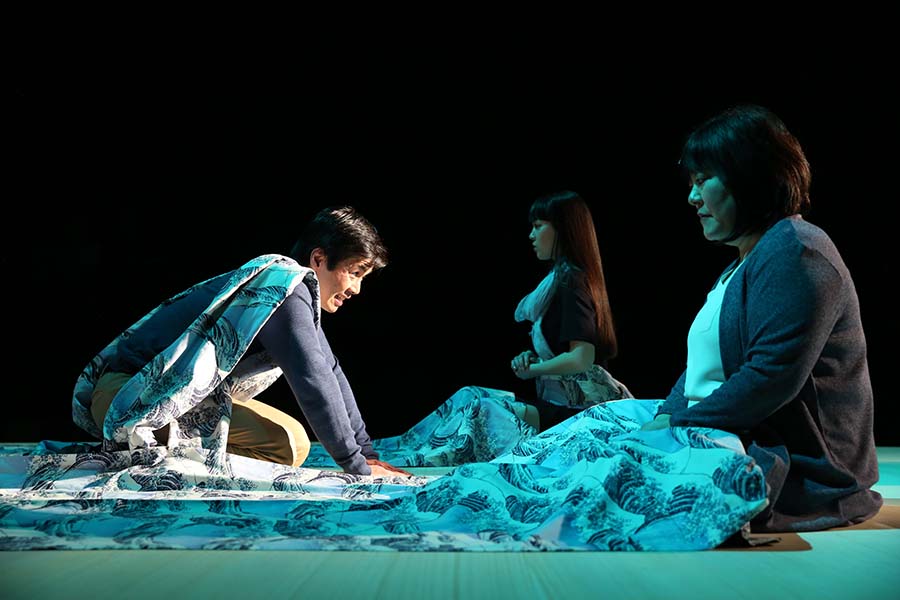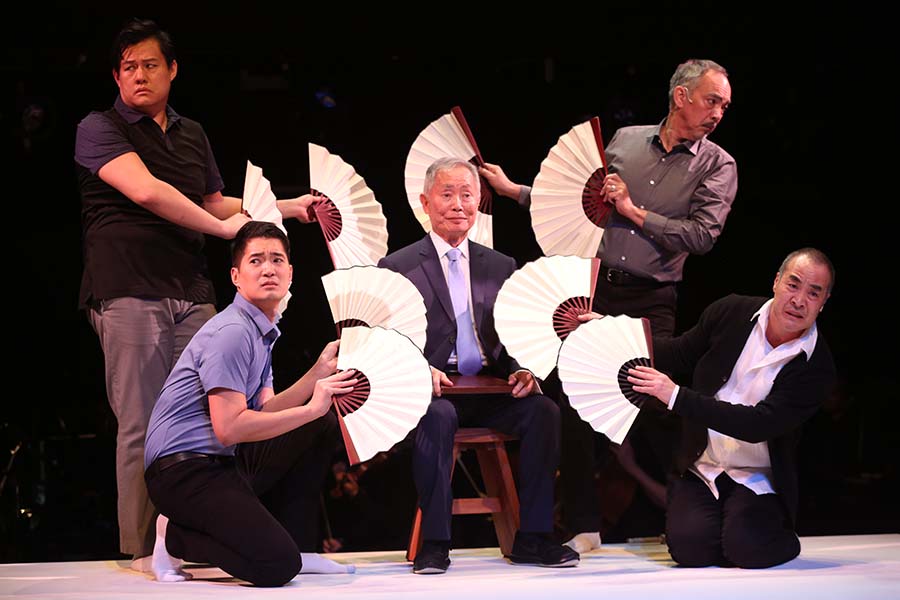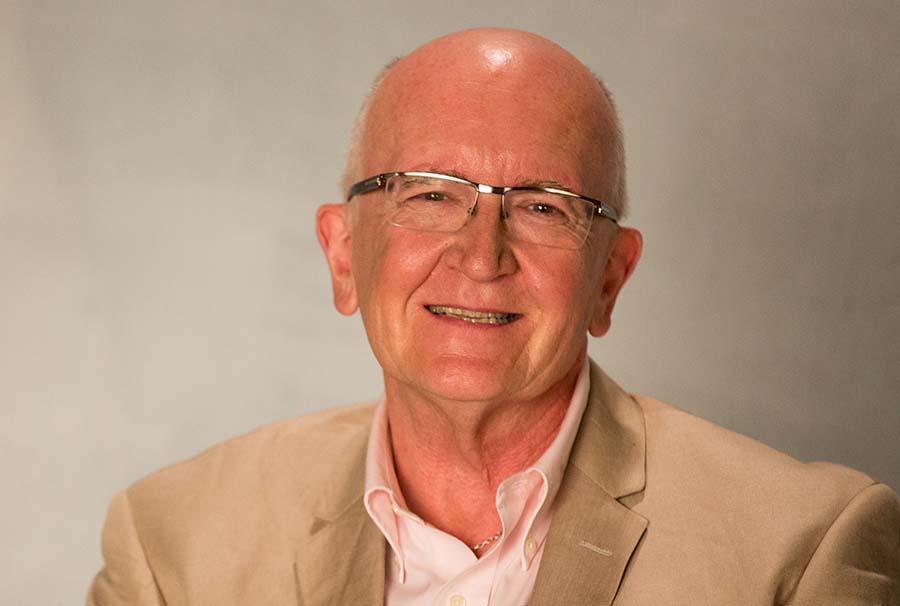It’s one o’clock on a warm April afternoon, and the Everyman Espresso on East 13th Street is buzzing, like any downtown coffee spot at that hour. But the words of the modest man sitting with me penetrate the cacophony of clanking cups and conversation like a clarion, so intense are they in their focus and passion.
John Doyle has been artistic director of Classic Stage Company for almost a year, and he’s got a lot to be excited about. His highly anticipated new production of Stephen Sondheim’s Pacific Overtures is in previews in CSC’s intimate theatre space, just steps through the café doors (performances run April 6-June 11). An internationally acclaimed interpreter of Sondheim’s work, Doyle’s radically reconceived production of Sweeney Todd on Broadway, starring Michael Cerveris and Patti LuPone, won him a Tony for Best Director of a Musical in 2006. A year later, his production of Sondheim’s Company starring Raul Esparza, won another Tony, this time for Best Musical Revival. In 2012, he directed Sondheim’s Merrily We Roll Along at the Cincinnati Playhouse in the Park.
At 64, the Scottish born-and-bred Doyle is enjoying a dynamic career in the theatre, one that keeps evolving and thriving. He’s directed more than 200 productions in the past four decade, and served as artistic director of no fewer than four British theatres in the 1980s and ’90s: the Everyman at Cheltenham, the Everyman at Liverpool, the Swan at Worcester, and the Theatre Royal in York. He’s earned distinction as a director of works other than Sondheim’s, as well: There was also Kander and Ebb’s The Visit with Chita Rivera, on Broadway in 2015, and his production of The Color Purple, which took the Tony for Best Musical Revival last year.
Still, Sondheim remains Doyle’s abiding love, and Pacific Overtures—about the “opening” of Japan to the West in 1853—isn’t even the first Sondheim he’s directed at CSC; he also helmed an acclaimed rendition of Passion in 2013. And so the Bard of Turtle Bay was the obvious subject of our conversation.
What was the genesis of your love for Sondheim?
In the ’70s somebody gave me a cassette of a show by Stephen Sondheim, whose name I vaguely knew at the time. I listened to it and I remember thinking, “This could be about me.” It was called Company. I remember being transported by the lyrics, and I played it so many times that the tape broke. Like so many people in my generation, we became fixated on what Sondheim was writing, but I never dreamed in a million years that I’d go on to concentrate on his work. In the 1980s, I directed two productions for which Sondheim wrote the lyrics: Gypsy at the Gaiety in Dublin and West Side Story at the Everyman in Cheltenham. Then in 1986 I directed Anyone Can Whistle, a 1962 piece with music and lyrics by Sondheim and book by Arthur Laurents. It was a terrible flop on Broadway, and we gave it a limited run at the Everyman anyway.
Next, I directed Sweeney Todd at Cheltenham, then Into the Woods at the Theatre Royal in York, then Candide (for which Sondheim wrote the lyrics) at the Everyman in Liverpool.
What inspired you to experiment with casting actor/musicians in Sondheim—the innovation that garnered so much attention in your Broadway productions of Sweeney Todd and Company?
I was a forerunner in my time on that idea. The production of Candide was the first time I decided to take the musician out of the orchestra pit and integrate him onstage as a storyteller. It was rooted in a kind of Brechtian notion of storytelling. I had a limited budget with a 10-actor cap per production, so I said to myself: OK, I’ll find actors who can play instruments. I find that it’s a means to an end. I’ve been doing that work for many years; after all, you can’t wake up one day and say, “I’m going to direct Sweeney Todd and Patti LuPone will carry a tuba!” It was audacious at the time, but now that’s our way of working, and it’s taught in drama schools around the world. I saw it coming, and I know my Sweeney opened the door on Broadway. Since then I’ve been delighted to see it done in Once, and again in Natasha, Pierre and the Great Comet of 1812.
How did you develop your minimalist style?
I’m Scottish. I come from a Presbyterian background. We don’t have a lot of stuff at home. My taste is one of simplicity. I like to ask the audience to use its imagination. Like in Sweeney Todd, for example, you saw a girl playing a cello sitting on top of a coffin. You have to suspend your disbelief. Now, in Pacific Overtures, an actor stands on a stool and sprinkles pieces of paper and the audience sees a tree. It’s a sparse, simple storytelling technique, so that the audience can use its imagination. The movies do what they do better. If there’s a forest that is required, let the movies show a forest, but in the theatre we use simple techniques, like sound, to access the audience’s imagination.
Did Sondheim become involved with your Sweeney Todd?
Sondheim came to see it in London on the West End; he’d heard that my production featured 10 actors who made music, but he had to physically hear it and see how challenging it was. No one had ever seen anything like it before. Sondheim got very involved with the production when it came to Broadway. In London, the actors were unknowns, but on Broadway we acquired stars. Stars can change the dynamic of the show, but that didn’t happen. Ours were completely in tune with the ensemble nature of the piece.
Your passion and dedication to Sondheim is remarkable.
It’s a privilege to be associated with his work. He’s a theatre artist. Everything he writes is rooted in character; nothing is superfluous. The great thing about Sondheim is that he is open to dialogue. He’ll take suggestions. He’s rightly protective of his work, and at the same time he’s very open to a director’s reinterpretation. He couldn’t have approved of my Sweeney Todd without that kind of openness, without wanting to see things grow and change. After all, it was 100 percent different from Hal Prince’s. I’ve been lucky—I also got to work with George Furth on Company before he died. I worked with James Lapine on Passion, and that was something, because he directed the original. And now I’m working with John Weidman on Pacific Overtures. He’s a marvelous person. We’ve been through Road Show (a.k.a. Bounce) together, with all the rewriting and reconstruction that was involved.
What draws you to Pacific Overtures? It’s one of Sondheim’s most ambitious and sophisticated works.
It’s always been my favorite, my “desert island Sondheim”: brilliant, clear, looking at a world we don’t know and aren’t familiar with. I wanted to bring out the political in it. If you’re going to tell this story at this time in America, you have to ask: Where is America right now? Does America see itself becoming isolationist? What right do we have to invade and tell other people how to behave? This is a good time to tell this story.

What changes have you made to the original?
It’s a two-act musical that we’ve done as a one act. I’ve cut one song, “Chrysanthemum Tea.” The writers and I felt that, with what I was trying to say with the piece, it might get in the way and halt the show. At the point where the number was originally, there’s a slight tendency for comedy to thrive at the expense of the Japanese. It’s a very dignified culture, and given all the political factors and economic and international pressures, that dignity was being eroded with the arrival of the Americans (and others). So there was a danger of keeping “Chrysanthemum Tea” so early in the show—namely, that of eliciting humor. With a production rooted in ceremony and ritual, as ours is, that song doesn’t work. In the future, when other people do it, of course it will be there. The people who know the score may miss it, but those who don’t, won’t know it’s missing. So Stephen and John and I agreed to cut it for this production.
Clearly your approach is a collaborative one.
You don’t work with people and not talk to them! I remember when I did Sweeney Todd on Broadway, I used to stand out on the street at intermission and hear people say: “How dare this guy do that to the show?!” And I thought to myself: “Do you think Stephen Sondheim doesn’t know what I’m doing?” All collaborators are part of the experience. In my case, I have a reputation of directing revivals. I’m not interested in imitating Hal Prince. My job is to look at the script and see what I see. In fact, it’s a tribute to what Hal has done.
So often in the U.S., the word “revival” is seen as a replication, rather than an opportunity to breathe new life into a work. We’ve gotten beyond doing Shakespeare as Shakespeare did it. We have to think about musical theatre in those terms as well. Because they are masterpieces, they allow the artist to see them in new ways. Last season, A View from the Bridge [directed by Ivo van Hove] and my Color Purple, both on Broadway, featured two artists looking at work and saying that it’s our job to do it in our way. Unfortunately, that can mean that you have to take a little flak along the way. There will always be a part of the audience that has a fundamental approach to how a work should be done—a nostalgic element. Good directors who do revivals don’t set out to trash the original. They’re honoring the original. They simply hear the words differently and see the work differently. For them, it’s a different experience.
You’ve designed the set for this Pacific Overtures yourself.
It’s very simple, but actually it’s quite epic for our space. For me, the stage [a long, white expanse] is a piece of parchment, like the great sheet of paper on which the original treaty between America and Japan was written. The Japanese lettering is the same. People can be placed on it. For me, that’s a metaphor.
You chose not to double actors as musicians in this Sondheim production.
I wanted fluidity and simplicity. Jonathan Tunick’s orchestrations are so beautiful that I wanted to provide an orchestra [of nine] to play them. In any event, I felt it would be culturally wrong to double actors as musicians in this one. Sweeney Todd is so weird that you can do anything with it. But with Pacific Overtures, it felt inappropriate for an Asian setting. And they’d have to be playing Japanese instruments.
What has been your biggest challenge with Pacific Overtures?
I wanted to make sure that the audience has an emotional connection with the people in the story. Some call Pacific Overtures a history lesson, but I say no—we should care about these people and their country.

What’s your next Sondheim?
I’d like to do all John Weidman’s pieces: Pacific Overtures, Road Show, and Assassins. One is very lucky to enter into conversation with composers and writers like these. Stephen Sondheim has an extraordinary understanding of the human condition, and that’s what I’m attracted to—works about who we are. Sondheim is the only person I know who could write a song with an older person and his younger version singing together [“Someone in a Tree” in Pacific Overtures]. It’s a wonderful notion, really.
At the end of your production of Pacific Overtures, there’s an empty stage, with a gun lying on the floor.
So much of our modern currency is about the gun, isn’t it? It’s about warfare. “We’ll keep other people in order by pointing a gun at them.” I don’t understand why individuals are allowed to own guns. Coming from Scotland, it’s beyond me. Meanwhile, what do we learn? At the end of Pacific Overtures, one of the characters has the gun and has to choose whether to use it or not. It’s lying near the American flag. Today Japan is a pacifist country. Meanwhile, we’re at a point where we don’t know what’s going to happen in China and North Korea. Is the gun the answer? I’m not setting out to say: “You Americans—you can’t keep telling other people how to behave.” But I do think that the best way is to behave well ourselves. I say “we” because I live here. So I wanted to have a political image at the end of the story.
Do you see it as political theatre?
Yes. I sat down with John Weidman, who wrote this in 1976, and asked him: “What was life like then?” John said it was the post-Vietnam War period. So I have to hold on to the fact that this is the voice that wrote the story. I have to honor the book writer as well as the composer. I wanted to honor John’s early political energy and see if I could answer the question that the final song “Next!” poses. What will happen next…today? None of us knows. We’re very vulnerable, we live in a time when theatre has a job to do that it hasn’t been doing for a while, and that is to ask the political questions. In Great Britain, the government gives us money in the theatre to explore political questions. Today is a time when our country is divided down the middle. The question has to be asked: Who are we? We’re not political parties, we’re humanity. The Greeks did it, Shakespeare did it. Theatre can be entertaining, it can be funny, but it should have a message to say to the world!
How are you enjoying your inaugural year as artistic director of Classic Stage Company?
I love it here. It’s a wonderful space. I feel privileged to have a home where I can do work and encourage others. I’d never tell guest directors how to direct here, but I’d like an overarching aesthetic. I don’t call it “minimalism,” I call it “that which is essential.” If we explore the essential on all sorts of levels, we’ll develop more audiences.


